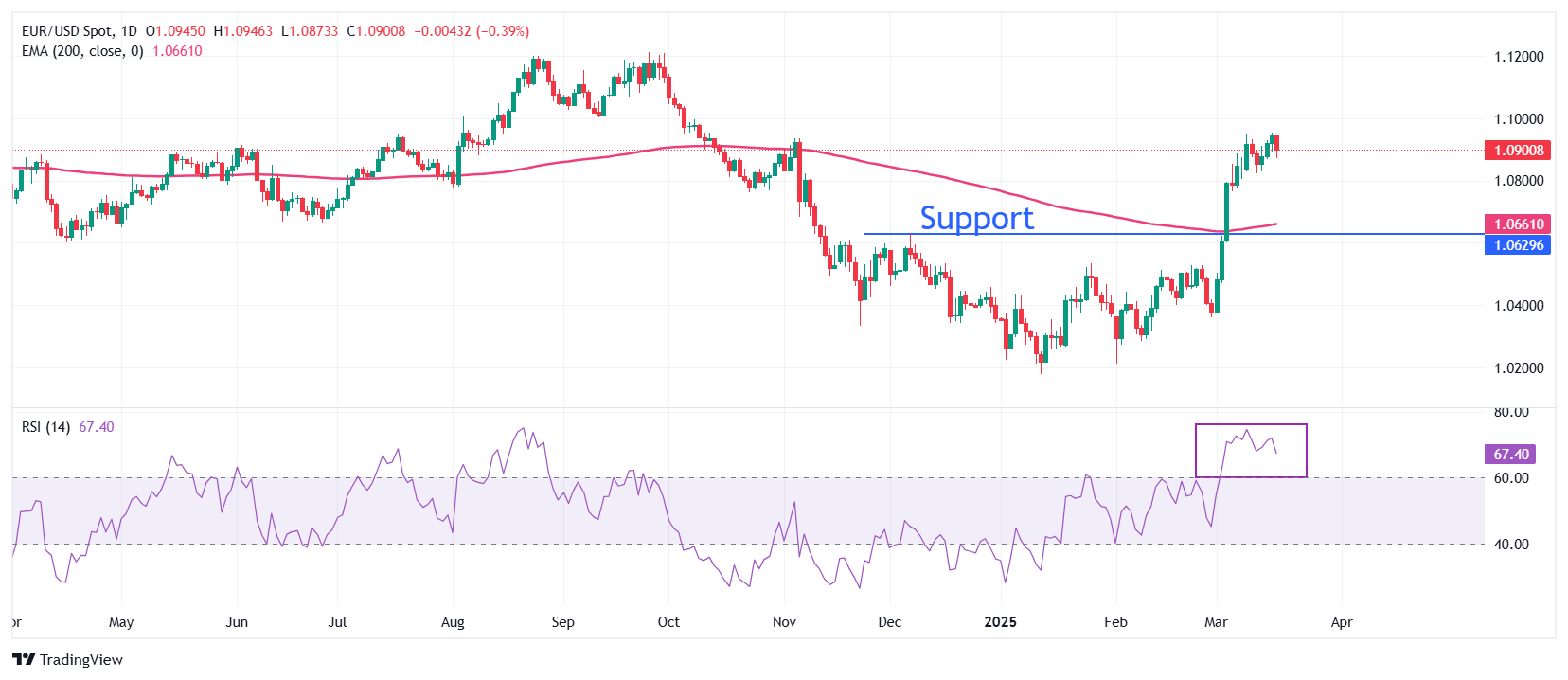提供最佳价差和条件
 了解更多
了解更多
EUR/USD falls sharply to slightly below 1.0900 in Wednesday’s European session after posting a fresh five-month high near 1.0955 the previous day. The major currency pair weakens as the US Dollar (USD) performs strongly ahead of the Federal Reserve’s (Fed) interest rate decision at 18:00 GMT. The US Dollar Index (DXY), which tracks the Greenback’s value against six major currencies, jumps to near 103.70 after revisiting a five-month low around 103.20 on Tuesday.
According to the CME FedWatch tool, the Fed is almost certain to keep borrowing rates steady in the range of 4.25%-4.50%. This would be the second straight policy meeting in which the Fed will leave interest rates unchanged.
Traders have remained increasingly confident about the Fed maintaining a status quo on Wednesday as officials have been arguing in favor of maintaining a “wait and see” approach until they get clarity over the United States (US) economic outlook under the leadership of President Donald Trump.
Market participants expect that Donald Trump’s tariff policies could result in a resurgence in inflationary pressures in the near term as the impact of higher import duties will be borne by US importers who will pass on the impact to consumers.
Apart from the interest rate decision, investors will also focus on the Fed’s dot plot, which shows policymakers’ collective forecast for the interest rate outlook in the medium and longer term. In the December meeting, Fed officials projected two interest rate cuts in 2025.

EUR/USD struggles to extend its upside above 1.0950. However, the long-term outlook of the major currency pair remains firm as it holds above the 200-day Exponential Moving Average (EMA), which trades around 1.0660.
The pair strengthened after a decisive breakout above the December 6 high of 1.0630 on March 5.
The 14-day Relative Strength Index (RSI) wobbles near 70.00, suggesting that a strong bullish momentum is intact.
Looking down, the December 6 high of 1.0630 will act as the major support zone for the pair. Conversely, the psychological level of 1.1000 will be the key barrier for the Euro bulls.
The Euro is the currency for the 19 European Union countries that belong to the Eurozone. It is the second most heavily traded currency in the world behind the US Dollar. In 2022, it accounted for 31% of all foreign exchange transactions, with an average daily turnover of over $2.2 trillion a day. EUR/USD is the most heavily traded currency pair in the world, accounting for an estimated 30% off all transactions, followed by EUR/JPY (4%), EUR/GBP (3%) and EUR/AUD (2%).
The European Central Bank (ECB) in Frankfurt, Germany, is the reserve bank for the Eurozone. The ECB sets interest rates and manages monetary policy. The ECB’s primary mandate is to maintain price stability, which means either controlling inflation or stimulating growth. Its primary tool is the raising or lowering of interest rates. Relatively high interest rates – or the expectation of higher rates – will usually benefit the Euro and vice versa. The ECB Governing Council makes monetary policy decisions at meetings held eight times a year. Decisions are made by heads of the Eurozone national banks and six permanent members, including the President of the ECB, Christine Lagarde.
Eurozone inflation data, measured by the Harmonized Index of Consumer Prices (HICP), is an important econometric for the Euro. If inflation rises more than expected, especially if above the ECB’s 2% target, it obliges the ECB to raise interest rates to bring it back under control. Relatively high interest rates compared to its counterparts will usually benefit the Euro, as it makes the region more attractive as a place for global investors to park their money.
Data releases gauge the health of the economy and can impact on the Euro. Indicators such as GDP, Manufacturing and Services PMIs, employment, and consumer sentiment surveys can all influence the direction of the single currency. A strong economy is good for the Euro. Not only does it attract more foreign investment but it may encourage the ECB to put up interest rates, which will directly strengthen the Euro. Otherwise, if economic data is weak, the Euro is likely to fall. Economic data for the four largest economies in the euro area (Germany, France, Italy and Spain) are especially significant, as they account for 75% of the Eurozone’s economy.
Another significant data release for the Euro is the Trade Balance. This indicator measures the difference between what a country earns from its exports and what it spends on imports over a given period. If a country produces highly sought after exports then its currency will gain in value purely from the extra demand created from foreign buyers seeking to purchase these goods. Therefore, a positive net Trade Balance strengthens a currency and vice versa for a negative balance.